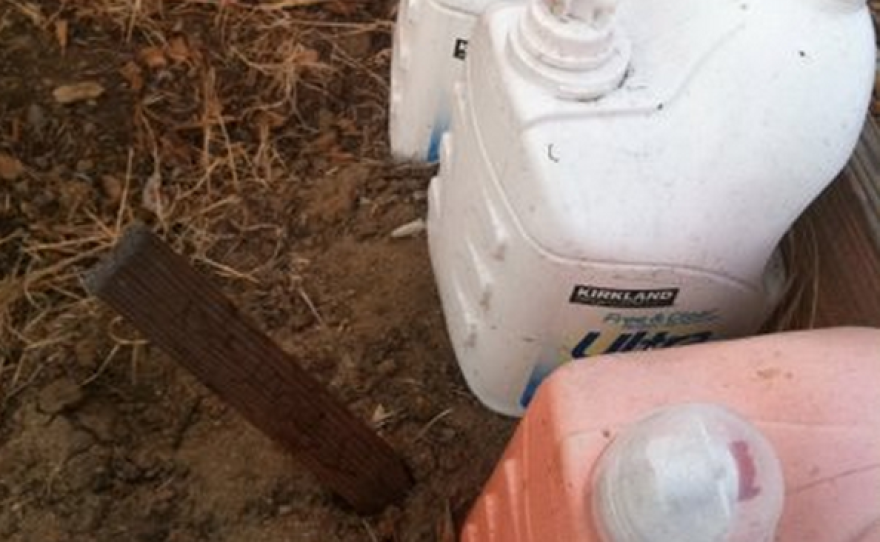At a small community garden on the corner of Ridgeview Drive and Fairmont Avenue in City Heights, there are a few plots filled with straggling end-of-summer vegetables. There are tomatoes, pole beans and squash, but the lot is noticeably bare. Out of the 19 garden beds, only six have anything growing in them.
That’s because gardeners at the Ridgeview Community Garden don’t have access to water on their land.
Instead of using a hose to water their beds, they’ve been hauling water from their homes in gallon jugs and old laundry detergent containers. Garden organizer Jeanette Neeley said it’s a heavy burden for many of the senior gardeners.
"If you can see some of the beds behind me, those are beds of 60-and 70-year-old people,” Neeley said. “They paid for the beds. They filled them. But without water, they just don't have the wherewithal to do that amount of heavy lifting.
"It's a chore anytime you have to carry water. Water is eight pounds per gallon, if you've ever backpacked the Sierras. So I can tell you that it's a challenge."
San Diego amended its ordinance on urban agriculture last year, lifting restrictions on backyard bees, chickens and goats. It also made it easier to establish community gardens. At least that was the goal.
Community garden advocates say there are still roadblocks — chief among them is the high cost of water.
The Ridegeview lot once had a water meter hookup that served former residents, but it was cut off and covered up when the home was removed and the lot was made smaller to widen a road.
Neeley said the city quoted the gardeners $11,000 to re-establish the meter. And it nixed their plan to tap into a meter for nearby city landscaping because there’s no system for billing the residents.
“We keep getting shuffled from department to department,” Neeley said. “No one wants to take ownership and create a process where we’re allowed to give them money. I know it sounds odd. If we could pay the bill, we would be ecstatic. That’s our goal.”
In Madison, Wis., most community gardens get water from hookups to fire hydrants. Baltimore has issued a $120 fee for installing water meters in community gardens. San Francisco has a grant program that cuts the cost for installing meters at community gardens significantly.
City of San Diego Public Information Officer Kurt Kidman said the city treats community gardens no differently than any other customer. He said as long as community gardens can round up the necessary funds to install a meter, water access should not be an issue.
He confirmed installing a meter can run in the thousands of dollars— a bill most community groups can’t foot.
Judy Jacoby is the director and CEO of the San Diego Community Garden Network. She said in comparison to other cities, San Diego still has a lot of work to do to support community gardens.
Jacoby said a first step would be putting a single city department in charge of all community garden queries.
“There is no one, actually, who feels it’s their job to help people out,” Jacoby said. “There is no liaison for community gardens. You can go to your council member and ask for help. They can be helpful, but it’s a matter of whether they choose to or not.”
Jacoby points out that in Seattle, community gardens are overseen by a staff of six in the city’s Department of Neighborhoods. Many other cities manage community gardens through their park and recreation departments.
Jacoby said the process in San Diego is so complicated that even she doesn’t understand all the nuances of establishing gardens on city-owned land. Kidman said there is no one in San Diego city government who is qualified to talk to the press about gardens.
“Knowing what department to go to and who to talk to with your list of questions really would make it a lot easier,” Jacoby said. “The code in and of itself is not everything.”
Jacoby said her organization has been working with multiple groups who want to start gardens in their communities. For some, several years have passed without any real headway. She said, while San Diego has come a long way, the city could do more to support the self-sufficiency of its residents.
“It all comes back to the question if the City of San Diego values community gardens and thinks that urban agriculture has a place in the city and that people who live in apartments should have a place where they can grow food,” Jacoby said. “Then it’s up to them to find a way to support it.”
After working with representatives from multiple city departments over the past two years, the Ridgeview gardeners think they may have caught a break.
They’ve been meeting with public utilities customer advocate David Akin, who suggests a possible solution to the high cost to access water is working on getting certain fees waived for the group.
While the gardeners say they want the city to make it more affordable for gardens to pay for water, Neeley said they don’t want a handout.
“The next step to me would be to streamline the process in just getting access to landscape water,” Neeley said. “Help us to help ourselves, not give us anything free. Allow us to get access to water, grow our own vegetables share with our neighbors.”






